There are 2,689 ETFs and Funds with active shares shorted in our Blacklight SaaS platform and Black App with $254 billion of short interest. Average Short Interest % of Float is 20.99% and S3 SI % Float (which includes synthetic longs created by every short sale in the Float number) is 15.94% while the average stock borrow fee is 0.85%. As a comparison, U.S. equites have an average SI % Float of 5.39%, S3 SI % Float of 4.85% and average stock borrow fee of 0.62%.
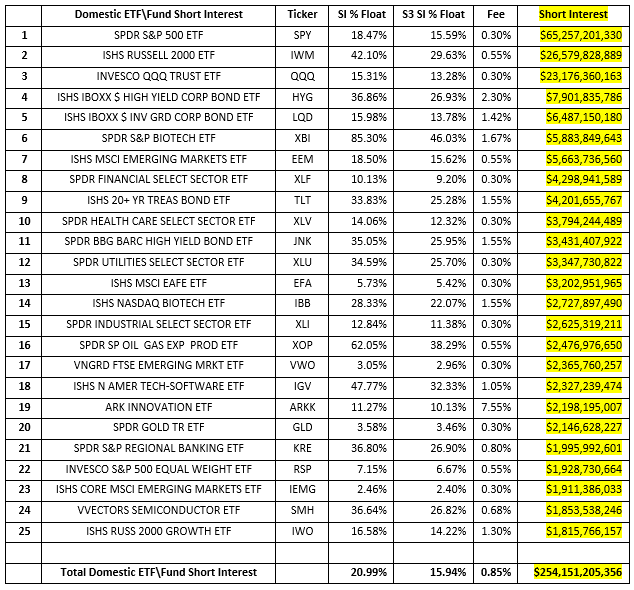
Overall ETF short exposure increased from $249.6 billion to $254.2 billion, an increase of +$4.6 billion or +2%, over the last 30 days. Change in short interest is comprised of mark-to-market price changes of existing shorts and short selling and covering. Over the last 30 days we saw a -$4.5 billion decrease in the market-to-market value of existing short positions offset by +$9.1 billion of net short selling. ETF short sellers experienced a decrease in exposure due to market weakness but shorted more ETFs to offset that decrease. This indicates that they were not looking to reduce their ETF short exposure and increased their short selling to rebuild their portfolio hedges or outright risk positions.
Fixed Income ETFs had large moves in short interest with increased short selling in the iShs iBoxx $ High Yield Corp Bond ETF (HYG), the iShs 20+ Year Treasury Bond ETF (TLT), and the Spider Bloomberg Barclays High Yield Bond ETF (JNK) versus short covering in the iShs iBoxx $ Inv Grade Corp Bond ETF (LQD). We also significant short covering in the Spider S&P Biotech ETF (XBI)Spider S&P Biotech ETF (XBI), the Spider Financial Select Sector ETF (XLF) and the Spider S&P Oil\Gas Exploration\Production ETF. And increased short selling in the iShs MSCI Emerging Markets ETF (EEM), Vanguard FTSE Emerging Markets ETF (VWO) and Ark Innovation ETF (ARKK).
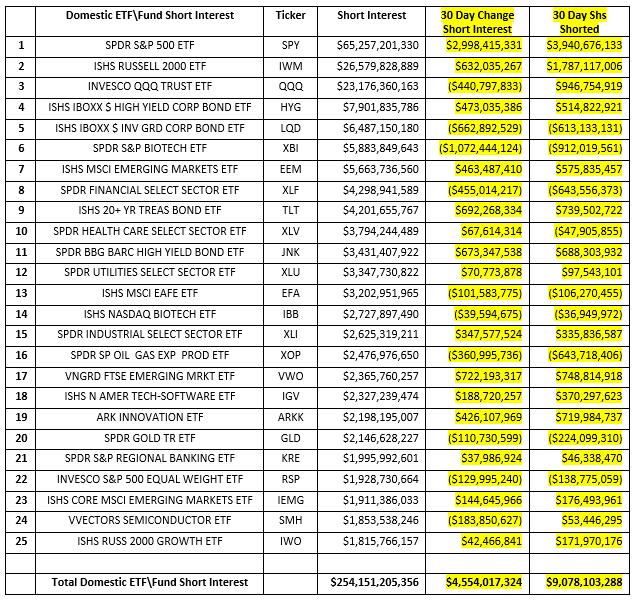
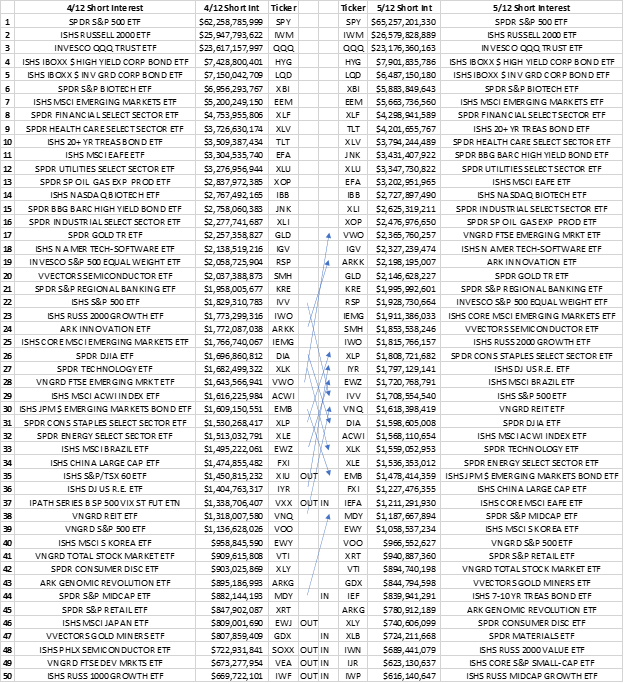
The previous chart shows movement in the top 50 ETF shorts since 4\12. Highlighted are ETFs which either gained or lost 5 spots in the short interest league table. The top 15 spots rarely change much, with ETFs moving 1-3 spots on a monthly basis. But the latter half of the group is usually involved in a game of musical chairs as market conditions change.
ETF short interest as a % of Float is a much more fluid metric than it is for equities and ADRs as ETFs are constantly created and\or redeemed which changes their shares outstanding\float numbers sometimes on a daily basis.
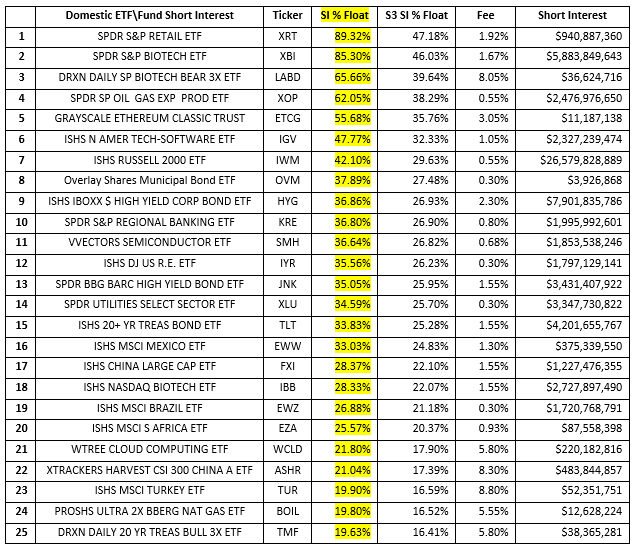
SI % Float is just one of the variables in our multi-factor Crowded Score along with the overall size of the short, stock borrow liquidity\costs and trading liquidity. Looking at all these factors, the most crowded ETF shorts all have high Short Interest % of Float numbers, but the other factors change the rankings in the Crowded league table.
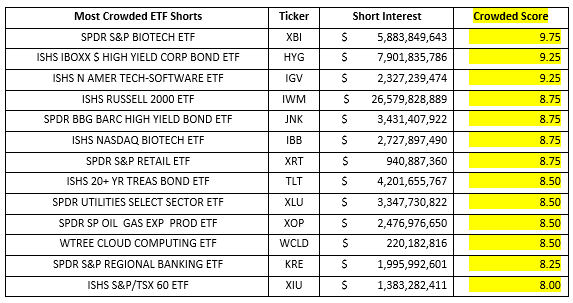
ETF stock borrow fees rarely get very expensive (over 5% fee) as brokers will create ETF shares in order to meet stock borrow demand as rates make the share creation and hedging profitable. Rates in certain ETFs tend to climb for two main reasons, there is very little marginable or rehypothicatable stock in the market which limits the stock lending availability pool or the process of creating and hedging the ETF is difficult or very expensive (active ETFs or illiquid constituents) . The following are ETFs with the highest stock borrow fees with short interest over $50 million.
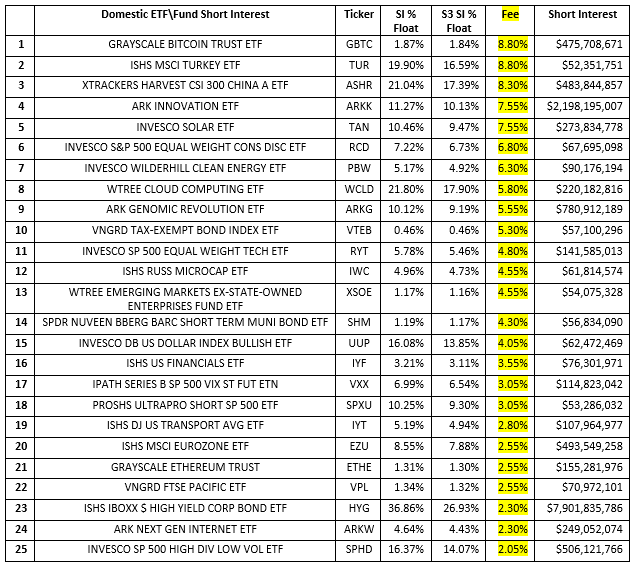
Institutionally ETFs are primarily used as a portfolio hedging vehicles (SPY, IWM & QQQ shorts make up 45% of total ETF short interest) so one can expect that in an upward trending market most of the larger ETF short positions would have negative returns, but price weakness over the last 30 days in the markets has allowed short sellers to recoup some of their year-to-date losses. ETF shorts are down -$12.0 billion, -4.81%, in year-to-date net-of financing mark-to-market losses. The worst performers were, as expected, the SPY and IWM ETFs with the QQQ ETF down less because of tech sector weakness. The best performers were a mix of hedging and Alpha positions in the VIX, fixed income and Gold. One outlier in the most profitable ETF shorts was the ARKK and ARKG ETFs which were recently heavily shorted positions looking for a retracement in the high tech stay at home stocks that performed well over the last year.
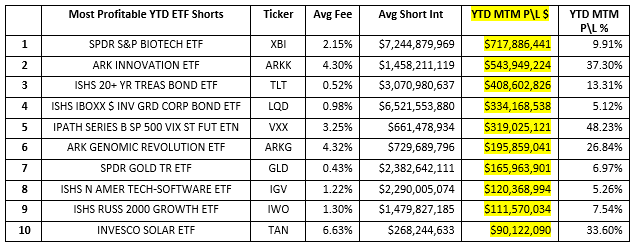
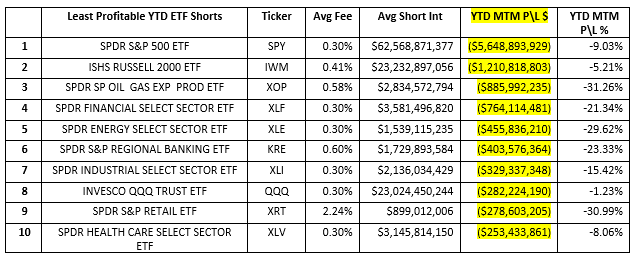
ETF shorts were up +$5.40 billion in mark-to-market profits, +2.09%, over the last 30 days. Looking past the big three hedging ETFs (SPY, IWM & QQQ) we see several tech based ETFs (ARKK, SMH, IGV & XLK) up over the last month while financial, energy and gold ETFs (XLF, ETHE, XOP, XLE, GLD & GDX) were down over the last month.
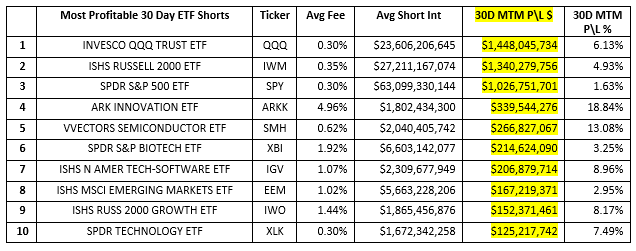
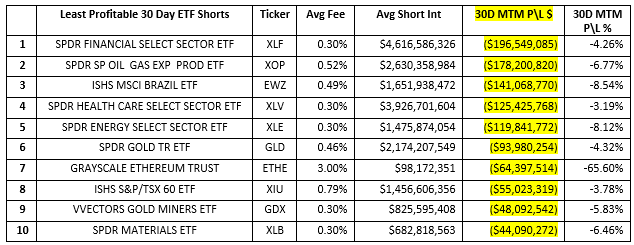
The ARKK ETF has been a very active short recently as there has been a surge of short selling in several of the ARK Investment family of ETFs due to their prior outperformance in the market. Overall, there is $3.39 billion of short exposure in ARK ETF’s with $299 million of new short selling in the group over the last 30 days.

Looking at short selling trends over time provides insight into overall market sentiment as well as the strength of bearish conviction in individual equities. Our Blacklight SaaS platform and Black APP provides an up to date view of short selling and short covering on an equity, sector, index, or country-wide basis allowing investors\traders to better manage their existing long and short positions.
Research Note written by Ihor Dusaniwsky, Managing Director of Predictive Analytics, S3 Partners, LLC
For deeper insight into short side data and analysis contact me at Ihor.Dusaniwsky@S3Partners.com
Click for 10 Day Complimentary Access to Bloomberg/S3 Black App Pro
The information herein (some of which has been obtained from third party sources without verification) is believed by S3 Partners, LLC (“S3 Partners”) to be reliable and accurate. Neither S3 Partners nor any of its affiliates makes any representation as to the accuracy or completeness of the information herein or accepts liability arising from its use. Prior to making any decisions based on the information herein, you should determine, without reliance upon S3 Partners, the economic risks, and merits, as well as the legal, tax, accounting, and investment consequences, of such decisions.